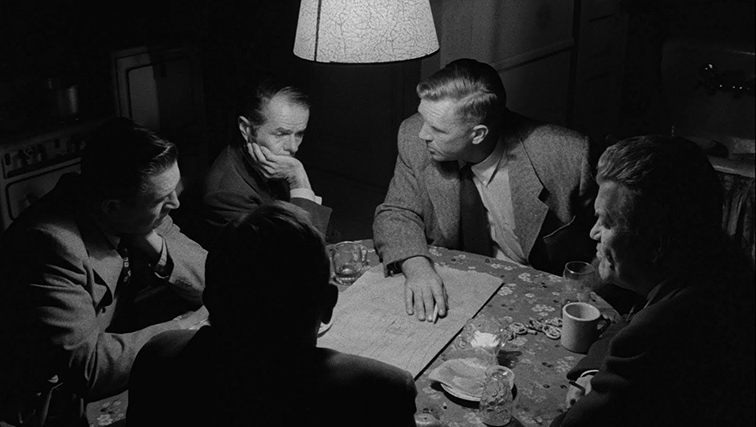Film Noir at the Racetrack: The Killing

This week the Film Forum in New York City is screening a print of the classic Stanley Kubrick film The Killing. Shot in 1956, The Killing was technically Kubrick’s third film, but by most people’s reckoning it was his first serious movie. The master filmmaker was 27 years old when he made The Killing. This film announced his arrival, however. It is still considered one of his best films by fans and students of his work.
The Killing is a film noir thriller that follows a group of criminals as they meticulously plan and carry out a broad-daylight heist on the fictional Landsdowne racetrack during the running of the feature race - the Landsdowne Stakes. The plan is complicated and we don’t learn every element of it until the very end. The story is told with multiple jumps in time and point of view. Quentin Tarantino said The Killing was a big influence on how he told the story in his movie Reservoir Dogs, and that influence shows. At multiple points during the movie’s 83 minutes we are taken back to the beginning to start over, each time seeing the events from the perspective of a different member of the gang.
For fans of noir crime stories, The Killing may not disappoint. Despite being a little unconventional with the filmmaking, Kubrick enlisted famed pulp-writer Jim Thompson, author of “The Grifters,” to help him with the script. The script wasn’t wholly original. It was an adaptation of a crime novel by Lionel White called “Clean Break.” Lionel White was himself a master; “the master of the big caper” according to the New York Times. Many of his books were adapted to film by greats such as Marlon Brando and Jean-Luc Godard. “Clean Break” was even almost optioned by Frank Sinatra before Kubrick snatched it up.
The story involves all the standard tropes of 1950s noir, plus a few elements that are uniquely Kubrick. For example, he cast the famous Soviet wrestler Kola Kwariani in a role as a thug-for-hire, despite the fact that Kola’s accent makes it impossible to understand a single line of his dialogue. But Kubrick and Kola were friends, having made each other’s acquaintance in the New York chess scene. Both Kubrick and Kola were avid chess players and regulars at various chess clubs in New York when Kubrick was a struggling filmmaker. Kubrick made the Kola’s character a chess player as well and set his scenes in a chess club, apropos of nothing.
Kubrick also turned the dark thriller into a story that combines humor, social commentary, and a heavy dose of irony - all elements of later Kubrick films. The movie transcended usual pulp-fiction fare as did the book it was based upon. And despite being a box-office flop, the movie put Stanley Kubrick on the map in Hollywood.
The Killing shouldn’t disappoint fans of horse racing, either. For the external shots of Landsdowne, Kubrick shot footage at Bay Meadows Race Course in Northern California. Because of the subject matter, the racetrack wouldn’t agree to let Kubrick film inside the track, so he built sets for those scenes. But Bay Meadows agreed to let him come shoot exteriors to use in the film. Kubrick’s director of photography showed up to the races all by himself with a single hand-held camera. The feel of the racetrack footage is markedly different than the rest of the film. It feels more like a documentary, like newsreel footage. But it is still artful. The scenes of the horses racing around the track keeps the camera focused in on the horses while the background whizzes by in a blur, making the race look like it is happening at blistering speed. The opening shot of the movie shows the horses coming out onto the track from the tunnel for the post parade, with a handsome contrast of shadow and light. The best shot of the film, however, of the horses preparing to break from the starting gate, was actually shot with the cameraman laying on the ground in the middle of the stretch. He had climbed over the rail and done this without asking permission, and was quickly nabbed by security and tossed out of the track. Kubrick said this was his favorite shot, and the full footage evidently included the camera being whisked up in the air, the fans in the stands cheering and laughing with delight.
The racetrack scenes, both internal and external, give a glimpse into what racing was like back then, during its heyday. You can see the Clydesdales pulling the starting gate into place, the various betting windows arranged by bet amount and type, you can hear the announcer call the tote board the “Totalizer,” and you can see what looks to be a hundred-thousand people gathered in the stands for a day at the track.
I’ll go ahead and tell you fans of racing now that part of the plot involves the gang shooting and killing a racehorse in the middle of the race. I won’t spoil the movie and tell you what happens, but I will say this - for those of you who love animals, fear not. The animals have their revenge in the end.
